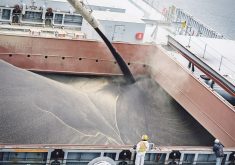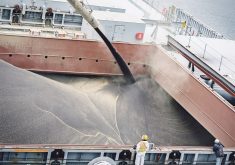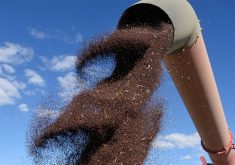Canola exports picked up in the last two months of the crop year, meaning full year exports were close to the figure in Agriculture Canada’s supply and demand report issued in June.
As well, domestic use wound up higher than forecast, so the year-end carryout should not be a burdensome factor.
Agriculture Canada had forecast 1.75 million tonnes of canola carryout.
Read Also

Flax sector sees omega-3 opportunity
SASKATOON — A global shortage of omega-3 oils could be an opportunity for the flax sector, says an industry official….
Adding up the export and domestic use numbers from the final Canadian Grain Commission weekly report for Week 52, it looks like the actual carryout could be slightly lower, near 1.5 million tonnes, so long as Statistic Canada does not revise its estimate of the 2023 crop at 18.3 million tonnes.
Exports over much of the crop year were slow because of brisk competition in the international market from Australia’s larger than normal crop. Exports to Mexico were particularly weak.
Canadian sales to China picked up in May and June, helping to make up the deficit and gave modest support to prices in the spring.
Nevertheless, total canola exports for the 2023-24 crop year were disappointing at 6.86 million tonnes, down 15 per cent from the year before.
As well, new-crop November canola futures by the second week of August fell well below $600 a tonne, the lowest since the fall of 2020. This followed the trend in the wider global oilseed market, which is taking its cue from soybeans.
As weather conditions in the American Midwest proved great for soybean growth this summer, the November soybean contract in Chicago plunged in July and early August, falling below US$10 a bushel last week.
The U.S. Department of Agriculture’s August supply and demand report forecasts the American soybean crop at a record high average yield of 53.2 bu. per acre and total production of 4.59 billion bu. That is 124.9 million tonnes, up 11.6 million from last year.
The USDA pegs the domestic soybean stocks-to-use ratio for the end of 2024-25 at a comfortable 12.8 per cent, compared to last year’s 8.4 per cent and only 6.1 per cent in 2022-23. The stocks-to-use ratio is the highest since 2018, when it reached 22.5 per cent.
The comfortable stocks-to-use ratio is similar to 2017, 2018 and 2019, when the ratio was consistently above 10 per cent.
That coincided with futures prices that were generally below $9 a bu., the weakest level of the 2010-20 decade.
The USDA also forecasts that the corn crop will have a record yield of 183.1 bu. per acre, but seeded area was down, so the crop is estimated to be the third largest ever.
In late winter, there was much speculation about the weather in the North American summer as the El Nino of the previous year weakened and signs pointed to development of a La Nina by harvest time. That meant that the El Nino-La Nina Southern Oscillation would be in a neutral phase through the North American summer.
It meant the oscillation would have little effect on North American crops. Other weather and climate systems would prevail.
For the U.S. Midwest, there were periods of extreme heat but rainfall was good, leading to the forecast for excellent yields, although harvest is still weeks away and things could change.
In Western Canada, the wet, cool spring and early summer got crops off to a good start but then in mid-July temperatures rose, especially in Saskatchewan and Alberta, and rain in most areas stopped.
Prairie crop production forecasts that were optimistic in early July faded with the heat and dryness, especially in much of Saskatchewan and southeastern Alberta.
Long-range forecasts for the Prairies indicate warmer-than-normal temperature averages into mid-September. Moisture chances are normal to below normal.
The U.S. Midwest also looks to have a warm and dry end to its growing season.
The expectation for a bumper U.S. soybean crop is clearly the dominant factor in the global oilseed market today, weighing down all prices, including canola.
However, in the coming months there might be some price support from the fact global canola/rapeseed and oil sunflower seed production will likely be less than expected because of weather problems in Canada, Europe, Ukraine and Russia.
The olive oil harvest in southern Europe is also expected to be below average again this year because of heat and dry weather.
And while soybean year-end supplies and stocks-to-use measurements are negatives for oilseed prices, the stock-to-use ratio for soybean oil, for the U.S. and for the globe, is expected to remain fairly tight.
However, palm oil production in Indonesia and Malaysia has increased recently. If that keeps up, it would be a negative factor on oilseed prices.
If we wind up with a lengthy railway labour work stoppage in Canada, that too would hurt prices.















